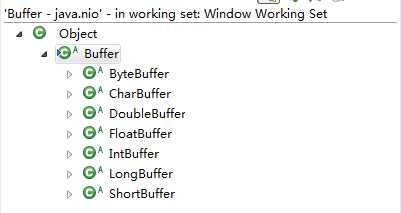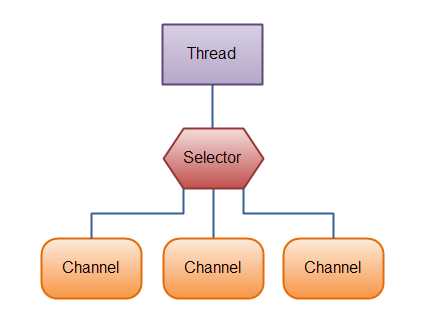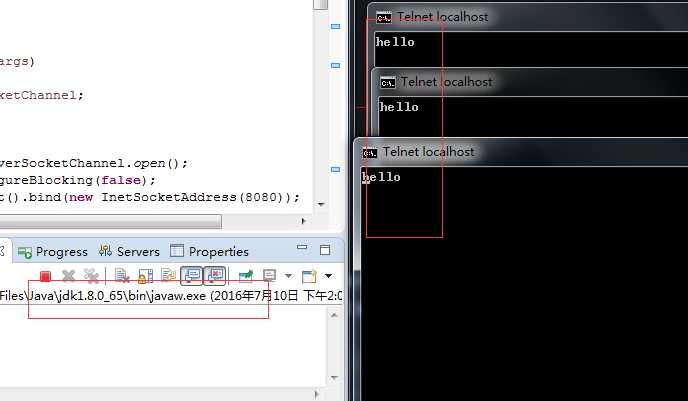标签:
Buffer是一个对象,包含一些要写入和读出的数据。
在NIO中,所有的数据都是用缓冲区处理的,读取数据时,它是从通道(Channel)直接读到缓冲区中,在写入数据时,也是从缓冲区写入到通道。
缓冲区实质上是一个数组,通常是一个字节数组(ByteBuffer),也可以是其它类型的数组,此外缓冲区还提供了对数据的结构化访问以及维护读写位置等信息。
Buffer类的继承关系如下图所示:

Channel是一个通道,网络数据通过Channel读取和写入。通道和流的不同之处在于通道是双向的(通道可以用于读、写后者二者同时进行),流只是在一个方向上移动。
Channel大体上可以分为两类:用于网络读写的SelectableChannel(ServerSocketChannel和SocketChannel就是其子类)、用于文件操作的FileChannel。
下面的例子给出通过FileChannel来向文件中写入数据、从文件中读取数据,将文件数据拷贝到另一个文件中:
public class NioTest { public static void main(String[] args) throws IOException { copyFile(); } //拷贝文件 private static void copyFile() { FileInputStream in=null; FileOutputStream out=null; try { in=new FileInputStream("src/main/java/data/in-data.txt"); out=new FileOutputStream("src/main/java/data/out-data.txt"); FileChannel inChannel=in.getChannel(); FileChannel outChannel=out.getChannel(); ByteBuffer buffer=ByteBuffer.allocate(1024); int bytesRead = inChannel.read(buffer); while (bytesRead!=-1) { buffer.flip(); outChannel.write(buffer); buffer.clear(); bytesRead = inChannel.read(buffer); } } catch (FileNotFoundException e) { // TODO Auto-generated catch block e.printStackTrace(); } catch (IOException e) { // TODO Auto-generated catch block e.printStackTrace(); } } //写文件 private static void writeFileNio() { try { RandomAccessFile fout = new RandomAccessFile("src/main/java/data/nio-data.txt", "rw"); FileChannel fc=fout.getChannel(); ByteBuffer buffer=ByteBuffer.allocate(1024); buffer.put("hi123".getBytes()); buffer.flip(); try { fc.write(buffer); } catch (IOException e) { // TODO Auto-generated catch block e.printStackTrace(); } } catch (FileNotFoundException e) { // TODO Auto-generated catch block e.printStackTrace(); } } //读文件 private static void readFileNio() { FileInputStream fileInputStream; try { fileInputStream = new FileInputStream("src/main/java/data/nio-data.txt"); FileChannel fileChannel=fileInputStream.getChannel();//从 FileInputStream 获取通道 ByteBuffer byteBuffer=ByteBuffer.allocate(1024);//创建缓冲区 int bytesRead=fileChannel.read(byteBuffer);//将数据读到缓冲区 while(bytesRead!=-1) { /*limit=position * position=0; */ byteBuffer.flip(); //hasRemaining():告知在当前位置和限制之间是否有元素 while (byteBuffer.hasRemaining()) { System.out.print((char) byteBuffer.get()); } /* * 清空缓冲区 * position=0; * limit=capacity; */ byteBuffer.clear(); bytesRead = fileChannel.read(byteBuffer); } } catch (FileNotFoundException e) { // TODO Auto-generated catch block e.printStackTrace(); } catch (IOException e) { // TODO Auto-generated catch block e.printStackTrace(); } } }
多路复用器提供选择已经就绪的任务的能力。Selector会不断的轮询注册在其上的Channel,如果某个Channel上面发送读或者写事件,这个Channel就处于就绪状态,会被Selector轮询出来,然后通过SelectionKey可以获取就绪Channel的集合,进行后续的I/O操作。
一个多路复用器Selector可以同时轮询多个Channel,由于JDK使用了epoll代替了传统的select实现,所以它没有最大连接句柄1024/2048的限制,意味着只需要一个线程负责Selector的轮询,就可以接入成千上万的客户端。其模型如下图所示:

用单线程处理一个Selector。要使用Selector,得向Selector注册Channel,然后调用它的select()方法。这个方法会一直阻塞到某个注册的通道有事件就绪。一旦这个方法返回,线程就可以处理这些事件,事件的例子有如新连接进来,数据接收等。
注:
1、什么select模型?
select是事件触发机制,当等待的事件发生就触发进行处理,多用于Linux实现的服务器对客户端的处理。
可以阻塞地同时探测一组支持非阻塞的IO设备,是否有事件发生(如可读、可写,有高优先级错误输出等),直至某一个设备触发了事件或者超过了指定的等待时间。也就是它们的职责不是做IO,而是帮助调用者寻找当前就绪的设备。
2、什么是epoll模型?
epoll的设计思路,是把select/poll单个的操作拆分为1个epoll_create+多个epoll_ctrl+一个wait。此外,内核针对epoll操作添加了一个文件系统”eventpollfs”,每一个或者多个要监视的文件描述符都有一个对应的eventpollfs文件系统的inode节点,主要信息保存在eventpoll结构体中。而被监视的文件的重要信息则保存在epitem结构体中。所以他们是一对多的关系。
功能说明:开启服务器端,对每一个接入的客户端都向其发送hello字符串。
使用NIO进行服务器端开发主要有以下几个步骤:
1、创建ServerSocketChannel,配置它为非阻塞模式
serverSocketChannel = ServerSocketChannel.open(); serverSocketChannel.configureBlocking(false);
2、绑定监听,配置TCP参数,如backlog大小
serverSocketChannel.socket().bind(new InetSocketAddress(8080));
3、创建一个独立的I/O线程,用于轮询多路复用器Selector
4、创建Selector,将之前创建的ServerSocketChannel注册到Selector上,监听SelectionKey.ACCEPT
selector=Selector.open();
serverSocketChannel.register(selector, SelectionKey.OP_ACCEPT);
5、启动I/O线程,在循环体内执行Selector.select()方法,轮询就绪的Channel
while(true) { try { //select()阻塞到至少有一个通道在你注册的事件上就绪了 //如果没有准备好的channel,就在这一直阻塞 //select(long timeout)和select()一样,除了最长会阻塞timeout毫秒(参数)。 selector.select(); } catch (IOException e) { // TODO Auto-generated catch block e.printStackTrace(); break; }
}
6、当轮询到了处于就绪状态的Channel时,需对其进行判断,如果是OP_ACCEPT状态,说明是新的客户端接入,则调用ServerSocketChannel.accept()方法接受新的客户端
//返回已经就绪的SelectionKey,然后迭代执行 Set<SelectionKey> readKeys=selector.selectedKeys(); for(Iterator<SelectionKey> it=readKeys.iterator();it.hasNext();) { SelectionKey key=it.next(); it.remove(); try { if(key.isAcceptable()) { ServerSocketChannel server=(ServerSocketChannel) key.channel(); SocketChannel client=server.accept(); client.configureBlocking(false); client.register(selector,SelectionKey.OP_WRITE); } else if(key.isWritable()) { SocketChannel client=(SocketChannel) key.channel(); ByteBuffer buffer=ByteBuffer.allocate(20); String str="hello"; buffer=ByteBuffer.wrap(str.getBytes()); client.write(buffer); key.cancel(); } }catch(IOException e) { e.printStackTrace(); key.cancel(); try { key.channel().close(); } catch (IOException e1) { // TODO Auto-generated catch block e1.printStackTrace(); } } }
7、设置新接入的客户端链路SocketChannel为非阻塞模式,配置其他的一些TCP参数
if(key.isAcceptable()) { ServerSocketChannel server=(ServerSocketChannel) key.channel(); SocketChannel client=server.accept(); client.configureBlocking(false); ... }
8、将SocketChannel注册到Selector,监听OP_WRITE
client.register(selector,SelectionKey.OP_WRITE);
9、如果轮询的Channel为OP_WRITE,则说明要向SockChannel中写入数据,则构造ByteBuffer对象,写入数据包
else if(key.isWritable()) { SocketChannel client=(SocketChannel) key.channel(); ByteBuffer buffer=ByteBuffer.allocate(20); String str="hello"; buffer=ByteBuffer.wrap(str.getBytes()); client.write(buffer); key.cancel(); }
完整代码如下:

import java.io.IOException; import java.net.InetSocketAddress; import java.nio.ByteBuffer; import java.nio.channels.SelectionKey; import java.nio.channels.Selector; import java.nio.channels.ServerSocketChannel; import java.nio.channels.SocketChannel; import java.util.Iterator; import java.util.Set; public class ServerSocketChannelDemo { public static void main(String[] args) { ServerSocketChannel serverSocketChannel; Selector selector=null; try { serverSocketChannel = ServerSocketChannel.open(); serverSocketChannel.configureBlocking(false); serverSocketChannel.socket().bind(new InetSocketAddress(8080)); selector=Selector.open(); serverSocketChannel.register(selector, SelectionKey.OP_ACCEPT); } catch (IOException e) { // TODO Auto-generated catch block e.printStackTrace(); } while(true) { try { //select()阻塞到至少有一个通道在你注册的事件上就绪了 //如果没有准备好的channel,就在这一直阻塞 //select(long timeout)和select()一样,除了最长会阻塞timeout毫秒(参数)。 selector.select(); } catch (IOException e) { // TODO Auto-generated catch block e.printStackTrace(); break; } //返回已经就绪的SelectionKey,然后迭代执行 Set<SelectionKey> readKeys=selector.selectedKeys(); for(Iterator<SelectionKey> it=readKeys.iterator();it.hasNext();) { SelectionKey key=it.next(); it.remove(); try { if(key.isAcceptable()) { ServerSocketChannel server=(ServerSocketChannel) key.channel(); SocketChannel client=server.accept(); client.configureBlocking(false); client.register(selector,SelectionKey.OP_WRITE); } else if(key.isWritable()) { SocketChannel client=(SocketChannel) key.channel(); ByteBuffer buffer=ByteBuffer.allocate(20); String str="hello"; buffer=ByteBuffer.wrap(str.getBytes()); client.write(buffer); key.cancel(); } }catch(IOException e) { e.printStackTrace(); key.cancel(); try { key.channel().close(); } catch (IOException e1) { // TODO Auto-generated catch block e1.printStackTrace(); } } } } } }
我们用telnet localhost 8080模拟出多个客户端:

程序运行结果如下:

1、netty权威指南(李林峰)
标签:
原文地址:http://www.cnblogs.com/xujian2014/p/5657540.html